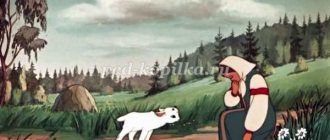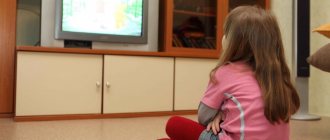Olga Ivanova
Card index of fun games for older children
Card index of games - fun for older children
Prepared by: teacher Ivanova O.V.
Fun games No. 1
«Potato»
Goal: To encourage emotional responsiveness, develop communication skills with adults and peers.
Move: All players stand in a circle and pass the ball to each other, hitting it. If someone does not hit the ball, he squats in the center of the circle and the game continues. Any player can help out the “offender” if he wishes. To do this, when hitting the ball, he tries to hit those sitting in (the one who was touched by the ball)
takes part in the game again.
Those sitting inside the circle try to catch the ball flying towards them.
If someone succeeds, then all those “punished” return to the game, and the player who threw the ball takes their place. Fun games No. 2
"Paints"
Goal: To encourage emotional responsiveness, develop communication skills with adults and peers.
Move: One of the players is the “buyer”, the other is the “seller”, all the rest are the “paints”. Each “paint” wished for its own color and told it to the “seller”. “Paints and the seller” sit on the bench and the buyer immediately comes: “Knock-knock!” “Who’s there?” asks the seller. "I, the buyer." “Why did you come?” “For paint”, “For which one?” A specific paint color is called; if it is not there, the “seller” replies: “There is no such thing. Jump along the path on one leg!” The “buyer” makes a circle on one leg and returns for more paint. If there is paint, the “seller” says: “There is one. Pay... rubles." The “buyer” “pays” - by clapping his palm the required number of times, the “paint” jumps up and runs away. The “buyer” tries to catch the paint ; if it succeeds, the “paint” becomes the “buyer”.
Fun games No. 3
"The quieter you go, the further you'll get "
Goal: To encourage emotional responsiveness, develop communication skills with adults and peers.
Progress: At a distance of 30 meters from each other, two lines are drawn - “ start ” and “finish”. The players stand at , the driver stands with his back to them at the finish line. He says the phrase: “The slower you go, the further you will go. One two Three!". During this time, players try to get as close to the finish line as possible. Having finished speaking, the “driver” quickly turns around and examines the participants in the game, who must freeze. The one who moves goes beyond the starting . the start line first wins . He becomes the driver.
Fun games No. 4
"Dodgeball"
Goal: To encourage emotional responsiveness, develop communication skills with adults and peers.
Move: All players, except two, stood in a line in the center of the court. They, throwing the ball to each other, had to knock out all the players. The one who was touched by the flying ball comes out! from the game. When all players were eliminated, the game started over.
Fun games No. 5
"Ring"
Goal: To encourage emotional responsiveness, develop communication skills with adults and peers.
Procedure: Play while sitting on a bench. Everyone folds their palms in a boat, and the leader, who has a small object in his palms (a ring, a pebble), runs his hands between the palms of each player, quietly puts a ring in someone. Stepping aside, he says: “Ring, ring, go out onto the porch! "The player with the "ring" must quickly stand up, and the other participants must hold him. If it was successful, he became the leader.
Fun games No. 6
"Magic Palms"
Task: exercise to develop a sense of one’s own movement.
Progress of the game:
“Water, water,
Wash my face (children perform washing movements)
To make the eyes sparkle (children show round eyes)
To make the cheeks red (children hold their cheeks)
So that the mouth laughs (children smile)
And the tooth bit him.” (children click their teeth)
Fun games No. 9
“Our Masha is small.”
Purpose: exercise to develop a sense of self-movement
DIY fabric toys
Soft cubes
It sounds strange, doesn’t it, because everyone is used to the fact that cubes are something wooden, plastic or any other hard polymer. But such heavy toys, if handled carelessly, can cause injury to the baby, not to mention the destruction that they can cause if they “successfully” hit, for example, a favorite vase; besides, they feel the same in their group.
At the same time, soft cubes, in the absence of the above disadvantages, will please not only the baby, but also his mother, and even his favorite vase.
Compound:
- any fabric material, any colors, it can be satin, calico, corduroy, felt, satin, velvet (the more varied, the more interesting it will be for the child),
- padding polyester,
- fishing bells of different sizes,
- letter stencil or any applique.
The fabric is cut into 10x10 cm squares with small seam allowances. Next, each square is worked out, a picture or letter is sewn on, after which all the pieces are sewn into a cube, leaving one edge unsewn, through which the toy is stuffed with padding polyester and a bell is inserted, then sewn together with a hidden seam by hand.
You can also put a plastic egg from a Kinder Surprise with beans, peas or cereals into the cubes as a rattle. It is also possible to use various rustling films.
They build pyramids from soft cubes, play football with them, put words or a puzzle out of them, in general, everything that the imagination suggests, these crumbs are not afraid of anything.
Fleece balls
These little fleece toys are truly adorable and even easier to make than the blocks, plus they're perfect for tactile stimulation with their strips running all the way around. Babies love them because they are very soft and easy to put in their mouth.
Soft pyramid
A slightly more difficult option to implement, but also more functional. You can not only examine, feel and chew, but also string it on a stick.
DIY children's toys made of fabric do not require special care; you just need to wash them in the washing machine, and they are ready to play again.
Fabric toys
Progress of the game:
Our Masha is small, (children bend down to the floor and show little Masha)
She is wearing a scarlet fur coat (children show the fur coat)
Beaver edge (children spread their hands and show the edge)
Masha black-browed (children point to eyebrows)
Fun games No. 10
“Cucumber, cucumber.”
Purpose: exercise to develop a sense of self-movement
Progress of the game: At one end of the playground there is a teacher (trap, at the other there are children. They approach the trap by jumping on two legs. The teacher says:
Cucumber, cucumber,
Don't go to that end
There's a mouse living there
He'll bite your tail off.
At the last words, the children run away, and the teacher catches up with them.
Fun games No. 11
Purpose: exercise to develop a sense of self-movement
“Fun toys as the basis of children’s play” material (junior group) on the topic
“Toys are fun as the basis of children’s play”
Fun toys can evoke an emotional response in a child, stimulate his development, intensify play, and promote the musical development of children. Thus, the problem of using toys to solve the problems of development of preschool children is currently relevant.
Purpose of the work: to expand the understanding of the richness of the world of toys and fun; show how toys influence the development of children of different age groups; promote the development of the emotional sphere of motor activity, expand the cognitive abilities of children.
The objectives of fun toys: To interest and captivate children with the beauty and unusualness of fun toys. Arouse interest in the toys of parents and grandparents. Expand knowledge about the history of Russian toys. To instill in children, through family and friends, kindness, responsiveness, love of traditions, and respect for toys.
Types of fun toys: “twitchers”; balls with elastic bands; gymnasts spinning on horizontal bars; jumping birds, frogs, butting goats, etc.; Folk toys made of wood and papier-mâché with ingenious devices that produce an amusing effect are widely known (pecking birds, carousels, moving wooden toys; amusement toys also include sets of tricks and surprise toys.
Their meaning: “fun toys”, as defined by E. A. Flerina, are used to entertain children; arouses curiosity, joy and positive emotions in children; maintain a cheerful mood, develop a sense of humor and curiosity; encourage children to study their structure, principle of operation, and also create a zone of shared experiences with adults. especially needed in children's groups of different ages, where older children can please the younger ones with a fun joint game with a funny toy; allow the teacher to establish contact with children, relieve tension, distract children from unwanted behavior, and create a desire to participate in joint play.
Basic requirements for the manufacture of fun toys
1) creation of a wide range for each age group of children;
2) a fun toy must be durable.
The influence of toys and fun on children under one year old: The child’s objective actions are related to his psychophysical development. As soon as the child begins to sit, he loves to manipulate the toy, trying, in imitation of an adult, to knock on a funny apple or pegs with a hammer. Children from five to nine months are shown toys that stimulate crawling, including large, bright tumblers. And these are one of the first toys that we classify directly as fun toys. A child enjoys playing with a tumbler doll at a very early age. The baby happily examines the tumbler, rocks it, pushes it, watches its movements and listens to sounds while playing. As soon as he drops this toy, it immediately takes a standing position on its own.
The tumbler is considered a traditional toy for children. It combines a rattle and a stabilizing device, attracts with its bright color, shape, comfortable and safe for the baby. According to the figurative solution, tumblers are, first of all, dolls, bears, dogs, birds, both of a design familiar to many generations and of an unusual design. There are also construction tumblers with parts of varying degrees of hardness and different sizes.
The influence of toys - fun on children from 1 to 2 years old.
After the first year of life, the child is also shown twitch toys, medium-sized or large-sized tops with a sound effect, and squeaker toys (when touched, a sound or melody is heard). For fun and development, there are educational games for children from 1 to 2 years old, and toy books have been invented (with a sounding device, for playing in water, etc.). Toy books with a sounding device are made of fabric, thick cardboard.
The influence of toys - fun on children 2-3 years old.
Fun toys for children under 3 years of age are intended to be played with an adult, under the supervision of an adult. But a one and a half year old child can already launch a small top. The toy develops fine motor skills well. A thin, comfortable handle, light weight, and the child enjoys learning to correctly calculate the strength and precision of the movements of the fingers and hand. A funny-sounding toy - a metal organ with a surprise. The barrel organ makes a pleasant melodic sound. Playing with a barrel organ promotes the aesthetic development of a child and improves the emotional background. First, the child is introduced to the inhabitant of the barrel organ, music is played, and then a surprise moment can be arranged.
The influence of toys - fun on children 3-4 years old.
For children 3-4 years old, figurines of animals and birds with a winding mechanism are especially interesting. Wind-up toys can diversify the actions of human and animal figures. The figures can be united by a common plot and represent toys that imitate actions (pecking, jumping, dancing, playing music) with various effects (musical, noise, color, light, etc.). Children independently play with pleasure with funny ducklings, pecking birds, and soft voiced animals that imitate the action. Bright, colorful bunnies, squirrels, bears, dogs, and cockerels immediately attract the attention of children. They find and recognize in these “fun” images of familiar animals and birds, and the game develops - children build houses for the animals, give them rides in cars, and invite them over for lunch.
The influence of toys - fun on children 4-5 years old.
At the age of 4-5 years, the nature of games for children changes, so folk toys made of wood (“Blacksmiths”, “Chickens on a Circle”, “Magpie and Squirrel”, “Gymnast Bear”, etc.) appear among the fun toys for them. funny figures with mechanisms (moving on an inclined board “Ducklings”, “Bull”, “Vanka-Vstanka”, etc.), bibabo dolls, voiced tops and tumblers, turntables.
The influence of toys - fun on children 5-6 years old.
Children 5-6 years old are interested in mechanical and electrified toys, as well as hydraulic, pneumatic, and articulated ones. The electrified railway is offered as a fun toy to be shown to children aged 5-7 years. Fun toys for children 6 years old are small tops made of different materials, homemade tops, figurines of animals and birds with funny movements, with music, singing or onomatopoeia, voiced (for playing “concerts”, etc.), funny caricatured animal figurines (with magnet).
Methods of practicing with toys and fun.
It is recommended to play fun games with preschool children every day in the morning or evening, when the teacher and children have a “free minute.” The duration of the fun games cannot be determined exactly. You need to play with children until they really have fun, rejoice and have fun. This time ranges from 1 to 5 minutes. It is not advisable to increase the duration of fun games, because overexcitation and overwork have a negative impact on children's health.
When conducting fun games with children, a mandatory condition is to provide them with free use of the toy with which the children acted under the guidance of an adult. It is advisable to accompany all the teacher’s actions with words: • first with direct instructions, • then with verbal instructions, of course, while focusing on the child’s experience. The content of fun games (shows) should be more “intricate” than children’s actions in independent play, but taken from real reality, close to the child. What is required from the baby? Carefully monitor the teacher’s actions and listen to his explanations. And this is only possible if he is interested. When playing entertainment with children, you should keep them all in sight, guide the children’s activities, immediately respond to emerging conflicts, and suggest the next course of action. The special task of the teacher is to arouse a keen interest in the game in children, to please them, to make them laugh, and to create a good mood.
Results of using fun games in educational activities:
• create a good, joyful mood in children;
• contribute to the establishment of positive relationships between the teacher and children;
• develop children's speech;
• develop fine motor skills of the hands;
• introduce the child to fun toys;
• enrich children's emotional experiences;
• contribute to the disclosure of the creative potential of the teacher.
Thus, fun toys (swinging bull, pecking chickens, blacksmiths, sawy bears) are intended to amuse and entertain the child. They evoke curiosity, joy, and positive emotions in children. Fun toys maintain a cheerful mood, develop a sense of humor and curiosity. They encourage children to study their structure, principle of operation, and also create a zone of shared experiences with adults. Fun toys help the teacher organize collective entertainment. This type includes surprise toys with a variety of movements, sound, light and other effects. The toys are simple, dynamic, with gentle humor. They show the wisdom, ingenuity, ingenuity of folk craftsmen, their love for children, and their desire to amuse them.
DIY educational toys for preschool children
Glove Monsters
Transform old gloves into these adorable little glove monsters that kids will love playing with. They're soft so you don't have to worry about hurting yourself, and you can make them with mismatched gloves.
If you use buttons for decoration, make sure they are sewn securely, especially if your little one still puts things in his mouth.
The toy is also great for sharing crafts with children.
Foam paper figures
You can cut out a variety of animals or people and ask the children to help you decorate them. When finished, attach them to the pencils. The puppets for the theatrical production are ready! All that remains is to write and rehearse the script. Or maybe your child prefers improvisation?
Finger puppets made of paper or felt
Using paper, foam paper, cardboard or felt, create original finger puppets that are easy to make and easy to bring to life.
Tube Characters
Use toilet paper tubes to create characters. With them you can create dozens of characters, the limit is your imagination!
Labyrinth
You will surely enjoy creating it and then playing with your child! To create it, you will need a thick cardboard box and ice cream sticks or cocktail straws.
Attention! Monitor the condition of toys and throw them away as soon as they are broken or torn. Do-it-yourself toys for kids, like store-bought ones, should not contain small parts; a child can inhale or swallow them. Children under 3 years old learn new objects not only by touch and sight, but also by testing their teeth, so the baby should play under your supervision.








